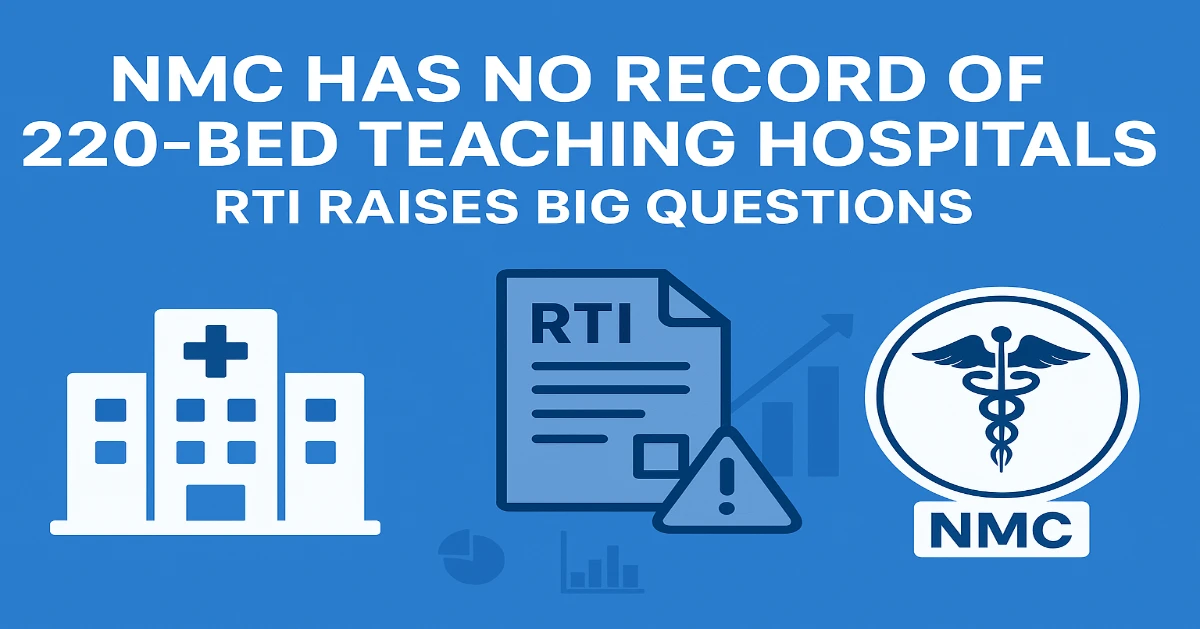New Delhi: A recent RTI query filed by the Federation of Resident Doctors Association (FORDA) has revealed a surprising gap within the National Medical Commission (NMC): the regulatory body reportedly has no official record of any “220-bed teaching hospitals,” despite notifying the rule earlier this year.
Understanding the 220-Bed Teaching Hospital Rule
In June 2025, the NMC notified the Medical Institutions (Qualifications of Faculty) Regulations, 2025, which introduced a major change in faculty eligibility and teaching hospital designation.
Key highlights of the new regulation
- Non-teaching government hospitals with 220 or more beds can now be declared as teaching hospitals.
- Doctors with a postgraduate degree and minimum 2 years of experience in such hospitals can be appointed as Assistant Professors even without mandatory Senior Residency.
- They must complete the Basic Course in Biomedical Research (BCBR) within two years.
- Those with 10 years of experience become eligible for Associate Professor posts.
- Postgraduate courses can begin with two faculty members and two PG seats, instead of the earlier requirement of three faculty and senior residents.
- Bed-to-unit requirements were relaxed to support expansion of PG seats.
The government’s larger target is to boost teaching capacity and enable the creation of up to 75,000 additional medical seats over the next five years.
Read Also: NEET 2026 Will Remain in Pen-Paper Mode? Challenges of Conducting Online Exam is Reason
RTI Response: “No Data Available”
When FORDA sought the list of government hospitals with 220+ beds designated as teaching institutions and the official orders supporting such designations the NMC’s Postgraduate Medical Education Board (PGMEB) responded that no such data exists.
This revelation has sparked concern across medical education circles. FORDA representatives have stated that such a major regulatory change cannot operate in ambiguity and that hospitals, faculty aspirants, and PG students need clarity on which institutions qualify under the new rule.
Read Also: NEET UG 2026 Questions: How to Solve MCQs Based on Question Types?
Why This Gap Is Serious
1. Transparency Concerns
A regulation of this scale requires clear documentation. Absence of records signals weak administrative control.
2. Confusion for Doctors & PG Aspirants
Without a published list, specialists seeking Assistant/Associate Professor posts cannot verify eligibility. This also affects those planning their senior residency or faculty track.
3. Risk of Arbitrary Implementation
If no official list exists, recognition could become inconsistent or discretionary, undermining uniform national standards.
4. Delayed Expansion of Medical Seats
States may be unable to convert hospitals into teaching institutions due to unclear guidelines and lack of formal recognition processes.
Read Also: NEET UG 2026 Chemistry: Chapter-Wise Weightage & Study Plan Based on NCERT+PYQ
What NMC Needs to Do Immediately
- Publish a comprehensive list of all 220-bed hospitals eligible or notified as teaching institutions.
- Release institution-wise designation orders, including dates and regulatory references.
- Establish a clear, transparent verification process for hospitals applying for teaching status.
- Provide grievance and clarification channels for hospitals and faculty applicants.
Read Also: NEET UG 2026 Biology Strategy: Chapter-Wise Study Plan Based on NCERT+PYQ Weightage


